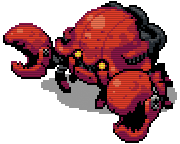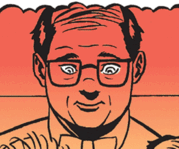|
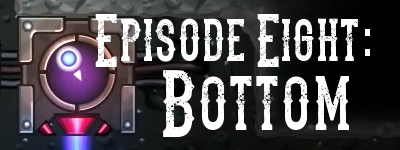 LashLightning posted:It doesn't look like you've found that while Rusty has that electric 'halo' around his body in the double jump, he causes damage to enemies touching him - you can double-jump into those guns and so on to quickly destroy them. I mentioned it works in the post, but if you need video evidence, this is the video for it. Dropping the turrets with the static dash is the easiest and most time saving method of killing the things, though it works a little less well on ground based enemies. One of the things I only noticed on this playthrough is that there are no flying enemies in the game at all. I find that interesting, but as you'll see in this episode, that is probably for the best because you have a really good chance of just falling down on the ground based ones already, adding flying obstacles to the mix would probably have doubled my deathcount in the game in just this last section alone. In other news, I totally misjudged how long it would take to complete the game, so next time for sure we are done. I know this because I already recorded it right after this one.
|
|
|
|

|
| # ? Apr 27, 2024 08:30 |
|
Started from the I like that the game vomits money and orbs on you at the end so you don't have to miss out on any upgrades. But are you unaware of the Water Seal that Biff still has to sell you, or just ignoring it on purpose?
|
|
|
|
C-Euro posted:Started from the I completely miss that he has that in his inventory still. At this point of the game there isn't really a need to pick up more water capacity/efficiency because I don't really need to steam jump anymore and most enemies are either going to blow themselves up or are better handled with the double jump, which really cuts my water consumption. I think I still buy one more upgrade anyway.
|
|
|
|
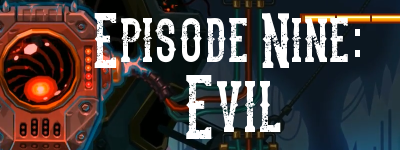 Alright, that's one down, potentially two to go. I've actually already started on Dig 2 and holy hell, everyone saying it was this game but more aren't kidding. I think the first episode is me just wondering at how they introduced more characters in the first ten minutes than this game has total and already had more story in one episode than through nine of this game. Before we get anywhere on that topic though, I have to say this is one of those games where I have just so few complaints. It's short, but it was supposed to be. At the same time it's replayable, this is something like my third time all the way through and I still can't get a gold rating. It's a fun, light game that isn't going to make you frustrated or upset at a fundamental unfairness or difficulty while still posing enough of a challenge and offering you both developer made challenges in the form of puzzles and necessarily forcing you to outsmart yourself in how you reach resources. That last factor is why I really love the game in the first place. There's nothing quite like realizing your own stupidity seconds before you screw yourself over in some way. The narrowing halo of light adds an element of challenge and surprise as you find you may have just blocked yourself off from a potential upgrade or possibly dug yourself into an inescapable hole. I was actually kind of impressed with myself because this was the first playthrough where I managed to not do that consistently. I usually have to pay out the nose for ladders due to my penchant for dumb moves. I feel like the only part of the game that really needed to improve was, oddly enough, the last fight. There aren't other boss battles in the game at all, so it was weird to have one to finish off the game. I would have loved like a chase or escape sequence that made you have to figure out how to best use your various abilities to get to the end instead of the fight, but as far as these things go it isn't exactly terrible, even if I get closer to death than I thought I would. Overall, it's a really fun game and I'm looking forward to digging my teeth further into the sequel.
|
|
|
|
Your video is unlisted again.
|
|
|
|
Chimera-gui posted:Your video is unlisted again. Alright, but what did you think of the semi-pun where I said "dig" instead of "sink" my teeth into the next game?
|
|
|
|
I haven't actually watched it yet because of the whole "unlisted" thing.
|
|
|
|
Chimera-gui posted:I haven't actually watched it yet because of the whole "unlisted" thing. He’s talking about his post.
|
|
|
|
XavierGenisi posted:He’s talking about his post. The puns in this thread? I can dig it
|
|
|
|
Let's not bury ourselves in puns this time. Especially not in gravel-y unfunny ones.
|
|
|
|
Lulti posted:Let's not bury ourselves in puns this time. Especially not in gravel-y unfunny ones. You need to learn to pick your battles better.
|
|
|
|
But we can surely pickax you to tone it down and stop shoveling it down our throats
|
|
|
|
Really digging deep on that one.
|
|
|
|
I think we can drill down to some better puns. The ones we've used so far are very sedimentary
|
|
|
|
mining
|
|
|
|
So while the next video uploads does anyone want to read...roughly 6000 words about Harlan County, Kentucky from about 1930 to 1934? I never finished the full text because of how the idea of the LP changed, but I definitely got paid a lot of money while writing it and it would be a shame if my company's money went to waste.
|
|
|
|
Look, I'm not saying you should create some Geop AssCreed level effort video but if you DID happen to 'acquire additional funding' from your workplace to create some Geop AssCreed level effort video I would definitely watch it. Or, y'know  . Was a great LP of a good game but I was looking forward to mine chat when you mentioned that in the OP. Would be good to read what you put together. . Was a great LP of a good game but I was looking forward to mine chat when you mentioned that in the OP. Would be good to read what you put together.
|
|
|
|
Post Mine Chat
|
|
|
|
The Harlan County Wars Part 1: Background note: I did a ton of research on all this. Oddly enough, some of the sources cite different dates and chains of events, so if I'm vague about something like that it's because I can't get an authoritative answer on it. If you want me to expand on anything I'll be more than happy to. There’s a really good chance that unless you live in Kentucky none of your history books contained a word about the Harlan County War. It sounds like a fight in the colonial era or some sort of offshoot of Bleeding Kansas or a less known Hatfield and McCoy conflict. Instead, it was a long and often violent conflict between miners and mine owners (and the government) that ran for most of the 1930s and earned the county the sobriquet “Bloody Harlan.” By 1931 the Great Depression was hitting every section of the economy hard. Still two years away from the introduction of the New Deal, there were huge numbers of idle workers in both the urban and rural areas of the country competing for what work was available; often on a day-by-day basis. While the New Deal wouldn’t immediately solve the labor crisis, the massive government funded projects like the ones undertaken by the Tennessee Valley Authority and the Civil Works Administration would employ hundreds of thousands during the depths of the Depression and had the dual purpose of both employing people and creating/fixing infrastructure in places that really needed it (there was also corruption, do nothing projects, and efforts to pay people to not farm their land, if we’re being completely fair). The Hoover administration and the Rugged Individualism concept favored by the President led to an administration that did extremely little to help alleviate the crushing poverty felt by many in the first few years of the Depression. Some sections of the economy were a bit more insulated from the Depression than others. Rapid electrification across the country had expanded the coal market in the years before 1929 as it was THE power source for the country. However, coal companies got ahead of themselves and ended up mining too much coal, which drove down the price per ton, which in turn led to lower profit margins and the Depression had made it more difficult to find credit to invest in machines that would have lowered labor costs. This led to the companies being even more sensitive to anything that may increase their cost of doing business. Before we get too much further with this story, the incredible pervasiveness of company power in a place like Harlan needs to be discussed. Starting in the late 1800’s in the US a number of companies would start building residential areas to house their employees, often building entire neighborhoods to house the workers of the mill or mine nearby. This wasn’t done out of the goodness of the company’s heart, but because it was necessary to even have people work in their facilities. In the days before fast personal transit it wasn’t really possible to live more than a couple miles from where you worked. Sometimes this resulted in tent cities a short distance from the mine or other production site as these places were often not located near existing towns or cities. Because of that and the aforementioned lack of personal transit companies had near monopolies on housing, food and consumer goods in their area of influence. By the time we’re discussing here, Harlan County was mostly comprised of company towns, with a small portion of the residents not reliant on the companies for nearly everything. The mining towns in Harlan weren’t just built by the coal companies, they were still owned by them. Miners and their families rented houses from the company, they saw doctors on company payrolls, the schools were company funded and most importantly, the stores were as well. Because the coal companies controlled nearly every part of the economic life of the miners, many companies would introduce something referred to as “company scrip.” Scrip was how companies worked around the issue of the remoteness of the worksites meaning legal currency wasn’t readily available in the large quantities needed for weekly payrolls. Instead of paying miners in real money, miners would get paid in scrip, often only valid for redemption in the town associated to the mine. Scrip was pegged to the dollar somewhat loosely, so if someone wanted to they could exchange Scrip for real money, but if they paid a fee. For a company, there wasn’t much reason to pay in anything but scrip when you think about it. Scrip would circulate back to the company as workers paid rent and bought things from the company run store, and the inability to use the currency elsewhere meant that moving to a different area would be massively unappealing as the miner would lose part of their life savings in fees paid to the company for exchanging the scrip for real money. Scrip was only part of the company domination of a miner’s life. The company would regularly read the mail of the miners, banned distribution of specific newspapers, arbitrarily docked pay for expenses that they may not have incurred and had a host of politicians and law enforcement officials in protecting it. When you think of an oppressive megacorp in some sci-fi novel you are just picturing what these coal companies were. While labor unions have been a thing in the US since around middle of the 1800’s and had been trying to organize workers in various fields ever since, it wasn’t until the Wagner Act passed in 1935 that employees had a guaranteed right to organize in the workplace. Prior to that employers could fire or remove employees who worked to form unions, so when the Harlan County War was getting started being a union member could get you fired and kicked out of your house. By 1931, unionization had become a popular idea among a number of labor sectors: Miners, construction workers, factory employees, shipbuilders, etc. Generally, people in industries where large companies held the power to dictate the terms of employment due to either the large labor pool or captive nature of labor in the companies concerned. The United Mine Workers of America had been attempting to organize the miners in Harlan and neighboring Bell county for some time by the time the situation boiled over. The UMWA had been around before the turn of the century and advocated for fair wages to be paid in real currency in addition to better safety and health considerations in the mines along with non-company controlled law enforcement. All of these would be extremely appealing to Harlan County miners, considering in early 1931 the local mine owner association (effectively an organization colluding on prices and wages, which is illegal today) determined it would decrease the price at which it sold its coal to increase market share (during a time where there was already too much coal in the market) and to subsidize the drop in price by cutting the wages of the miners. This didn’t sit well with people who didn’t make much money for backbreaking and dangerous work and were already underpaid. The cut, dropping the average miner’s wages to the point where they made about $750 a year from $1235. That would be around $12,600 and $21,000 respectively in 2019 money. Many mine bosses attempted to head off union agitation against the starvation level wages they had been reduced to by firing miners they knew had ties to the UMWA. Instead of fixing the problem before it started, they just made it worse as this inspired other miners to go on strike in solidarity. By the spring of 1931 a majority of Harlan’s miners were on strike. This would ultimately kick off the events of the Harlan County War.
|
|
|
|
More history of labor organization in Kentucky mining, please! This is great.
|
|
|
|
Kacie posted:More history of labor organization in Kentucky mining, please! This is great. Note: I've had the first Dig 2 video ready to upload for almost a week, I'm going to try and actually post it tonight. Part 2: The Shooting Starts The striking miners and those the mine owners had found had union ties were promptly kicked from their mine owned homes and relied on the few non-mine owned settlements for assistance. They usually congregated in large groups outside of these towns, which is partially the cause for the events I'm about to describe. The "war" began on May 5th, 1931 just outside of Evarts, Kentucky. Evarts was one of the few aforementioned towns not owned and operated by the mines in Harlan, and had become a sort of refuge for the striking miners. In what almost seems like an attempt to provoke the striking miners, the Black Mountain Coal Company sent a motorcade of three cars through town. Each car contained armed guards employed by the company and given deputy status by the local sheriff, an extension of power that had essentially become automatic when a guard was hired in Harlan. Thugs is the best way to describe the men in question. Many of them had convictions prior to getting hired and few seem to have had qualms with further violence. The contents of the cars are kind of hard to pin down, outside of the guards. I’ve seen versions of this that don’t sweat the contents, but also versions where the motorcade was transporting a replacement worker (scab) and his belongings, another where there were just supplies and another where there was no scab whatsoever and it was just a scab’s possessions being moved. Likewise, the actual start of the Harlan County War have been obscured by time and spin from both sides. Some sources say the ex-miners were laying in ambush that morning. Others say the cars drove past a collection of miners by coincidence. Either way, all the sources agree a single shot was fired and began the so-called Battle of Evarts, a gunfight that lasted 15 minutes and consumed maybe 1000 rounds. The reason the battle between miners on foot and driving cars became a protracted firefight is that the hired guns made the call to stop their vehicles and return fire rather than driving the hell away. I can’t find a reason for that particular decision, but it seems kind of insane knowing there were more miners than guards and that Harlan’s gun ownership was extremely high and the county itself had once had the highest homicide rate in the country in the 20’s. Both sides were well versed in violence and so assigning blame this long after the fact is not something I can comfortably do. Either way, four thugs and one miner were killed that day. Now, if this were a movie this is the point where the idealistic son of a mine owner finds a way to kick his dad out of the company and starts righting wrongs. He starts paying people a fair wage in real money, he fires all the hired guns, he introduces new safety standards and gives the miners the homes they live in. Everyone is happy and the only people that died were the worst of both sides. Of course, this is real life and there was no mine operator scion waiting in the wings to make things better for anyone. Instead of calling in mediators to get past the labor disputes that had caused the deaths of multiple people the mine owners called in political favors and Kentucky governor Ruby Laffoon sent in 370 National Guardsmen on May 24th. Apparently the majority of the residents of Harlan County weren’t aware that the mine owners had immense political power and believed the NG was called in to help them instead of the mine owners. The joke was on them, though as the NG had/has a history of being sort of a legal strikebusting force over some sort of citizen defense organization (seriously, this is worth looking up, the National Guard as we know it more or less started to help factory/mill/mine owners when the workers started demanding things) . The NG was used to supplement the hired guns at the mines and were supremely disinterested in the plights of the miners, with one guard official telling miners begging for relief that if they were so hungry they should get back to work. By this point something like 6000 miners were on strike and less than 1000 were at work. The Battle of Everts had caused mass walkouts by sympathetic miners.
|
|
|
|
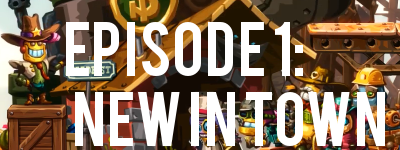 I was trying to pick a more modern looking font for Dig 2 videos, I'm not sure I'm happy with this one yet. Anyway, Dig 2 is a delight and I'm super excited for people to experience it with me. Yes, Fen is a bit generic (a small sidekick who loves to destroy vs. a protagonist who is all about order and being good is sort of a trope in a lot of media), but most of the characters are pretty fun and the art and animation is top notch. The game already feels bigger than the first Dig, something that will become more apparent by video 3 and a bunch of quality of life improvements abound. I don't want to spoil too much about the first video and there isn't a ton to really say as it is the tutorial section we see here. In future posts I'll talk a bit more about the overall experience and such.
|
|
|
|
I do like how they used Dot as the new hero, and didn't just leave her statement about looking for Rusty at the end of Dig1 as a loose thread. Also, the the colors and art style make the graphics really, really pretty!
|
|
|
|
Hello. I worked on this game from pretty much day one, but I was not involved in the first game at all so I've put off posting until now. The main goal going into this project was, I think, to make a bigger and better Dig with the better technology we'd developed during Heist and upgraded graphical style, which I think ultimately we pulled off. Dig 1's graphics were made in Flash and exported into our engine, including special effects like explosions and whatnot; Dig 2 features a fully featured custom particle system engine and rigid skeletal animation for all the characters, built in Blender and Illustrator. The area at the start there, the tutorial temple, was built pretty early on as I recall, but it also went through a lot of revision before it settled on what it is today. It become kind of a test bed for a while for what we could do with non-randomly generated areas and scripting together things like levers and doors. Oh, yeah, unlike Dig 1, this game is designed all the way through. The only procedurally generated parts are some random mineral spawns. A slightly modified version of the tutorial temple would also eventually make it into the various show floor demos when the time came to show it off to the public for the first time. We expected people to go to the right first, as that's what people generally assume is the way forward, only to run into that switch/door combo that you can't pass through without the sprint hydraulics, and then be forced to go the other way to unlock it and segue into the sprint tutorial. On a somewhat amusing note, you mentioned sequence breaking at a point in the video that's very close to one of the biggest sequence breaks in the game. I won't mention all the details, but you can go directly from the starting area to one of the final areas in the game, circumventing getting Fen entirely, if you know how. It used to be even easier due to an oversight with the jumping physics that could let you trivially jump some thirteen times higher than you're supposed to be able to - that was patched out, but the sequence break is still possible. El Machino, too, was built pretty early, but the first version of the place was sparse and undecorated and languished like that until very late in the game's development - I think we only finished it a few months before going gold. We wanted it to feel a little more vertical than Tumbleton, to give the player more sense of scale and allow them to use their movement options a little more, even in town. Cog upgrades were another thing that changed a lot during development, but we'll get to those later I suppose. That big empty space to the right next to the danger sign used to be a lake for a chunk of the game's development, but was changed for reasons I'll mention when it becomes more relevant. What else... oh, those enemies are called Trilobites. They're meant to be the same enemy as the ones you fight in Dig 1, but with the charge attack added to make them a bit more exciting. Nevertheless, they are not the first enemy to be added to the game - that would be an enemy we haven't seen yet.
|
|
|
|
Hyper Crab Tank posted:Hello. I worked on this game from pretty much day one, but I was not involved in the first game at all so I've put off posting until now. I was looking forward to these insights. It really feels like the team made every effort to address the stripped down or limited nature of the previous game. The expanded story and art/animation are good examples, but even the things like the more populated town and the speech bubbles that appear over character's heads when they have something new to say are improvements. Were there any upgrades/improvements along those lines that were targeted but you just couldn't make work or feel right?
|
|
|
|
Lazyfire posted:Were there any upgrades/improvements along those lines that were targeted but you just couldn't make work or feel right? A couple things come to mind, but to avoid spoiling material we haven't seen yet, I think it's better to hold on to some of those things until we get the points where they would've become relevant. Some of them have to do with tools and upgrades that haven't been shown yet, for example. I believe at some point the designers considered the idea of allowing you to invest in/upgrade buildings in El Machino - for example, upgrading the ore smeltery to improve the yield of resources extracted from raw minerals - but this never proceeded beyond the design stage. I think it was considered too clunky, too far detached from the core gameplay loop and not worth the effort. The conversation system was rebuilt from the ground up for this project, which includes a lot of the little improvements like speech effects (e.g. shaking text), branching conversations and the little "..." popups above the heads of people who have something to say. Integrating it with the visual scripting system proved to be somewhat troublesome though.
|
|
|
|
Hyper Crab Tank posted:A couple things come to mind, but to avoid spoiling material we haven't seen yet, I think it's better to hold on to some of those things until we get the points where they would've become relevant. Some of them have to do with tools and upgrades that haven't been shown yet, for example. I believe at some point the designers considered the idea of allowing you to invest in/upgrade buildings in El Machino - for example, upgrading the ore smeltery to improve the yield of resources extracted from raw minerals - but this never proceeded beyond the design stage. I think it was considered too clunky, too far detached from the core gameplay loop and not worth the effort. I did like the addition of conversation options in some of the interactions, while not a huge deal it was nice to see Dot isn't just a Rusty stand in. On the refinery: is the inability to make that work where the idea to increase your return on ore sales as you level up came from?
|
|
|
|
I believe that's part of it. I wasn't involved in that particular decision. In general, what the increased sell value as you level up does is encourage you to defeat enemies rather than just ignore them, and smooths over your money gain in the late game as you start getting to the point where most of the easily accessed minerals are already mined out. The person who did all the economic balancing - again, not me - probably felt it necessary and was looking for the right way to implement it.
|
|
|
|
Hyper Crab Tank posted:The main goal going into this project was, I think, to make a bigger and better Dig with the better technology we'd developed during Heist and upgraded graphical style, which I think ultimately we pulled off. And you nailed it. Dig 1 was pretty good, but a bit bare bones. Dig 2 really improved on everything Dig 1 did. After playing Dig 1, every time I though "I wish there was <feature>" it was in Dig 2. Well done.
|
|
|
|
"Height: 1 Tile" is a great gag so I'm already on board with this.
|
|
|
|
C-Euro posted:"Height: 1 Tile" is a great gag so I'm already on board with this. Yeah, that was when I started smiling, and I didn't stop until the end of the video!
|
|
|
|
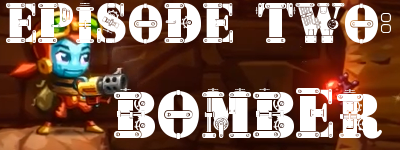 Good news: I found a better font. Too bad it is absolutely massive and will be a pain to use in the images going forward. It looks really nice, though. We get our first new-to-Dig upgrade in this video, the pressure bomb launcher. Think of it like Rusty's steamfist, but with less range and with a countdown before it does damage. I don't have many complaints about it, partially because I don't need to charge it up to increase range and damage, which was one of the more annoying aspects of the fist when you were suddenly confronted by a few different enemies and needed them to not be alive anymore. The pressure bomb is more a traversal tool than a weapon, especially at the early stage where you only have two shots before needing to refill on steam and when the explosion will damage Dot if she's too close. There is a Cog system upgrade that negates the latter, and I'm sure as we go on tank capacity and efficiency will make using the pressure bombs more freely. I have to say I really like that the fact that we're getting upgraded by a different type of machine and so our upgrades are functionally and thematically different while still being in the same vein as what Rusty got in the previous game. I can imagine the Spark Dash's steambot designed version using a jet of steam to give you a double jump, for instance. It's still the same concept and use, but clearly designed by robots used to steam technology and not electricity.
|
|
|
|
Noticed you missed a secret in one of the caves and it didn't get the checkmark, so at least it should be easier to see if you got them all in a cave in this one.
|
|
|
|
I just want to say that the town theme in Dig 2 is incredibly good.
|
|
|
|
Yeah I had a really strong sense of nostalgia as soon as I heard it and I only played this a year ago. Had to reinstall for a second playthrough.
|
|
|
|
When you pick up an artifact, do pop over to the artifact tab in the pause menu and read the descriptions. Our writers spent quite a bit of time on those! Not to mention the poor localization company that had to deal with the constant stream of puns and 80s references. Speaking of artifacts, that was originally envisioned as a much more complex system where there were multiple collectors up in town that wanted different artifacts, and you had to figure out which artifacts they were interested in. Someone who wanted something zoological might want that rat you picked up, or something else of a similar nature. Each collector had their own list of rewards. However, the system was almost impossible for players to understand, and what's worse you could make sub-optimal choices and screw yourself out of rewards down the line. It was considered way too unfun, so it was simplified to a single collector and you can't miss out on any rewards. Water refills in town, as you noticed. It didn't always work automatically - that's what the lake was for in that spot to the east of the town proper. It was changed because it was just meaningless busywork to pop over and take a bath every time you came up to town. This game has a lot more secrets than Dig 1, so the challenge caves now get a green check mark when you've got everything of value from one. Completion percentage is also shown per-area on the map screen. Criss-Cross Combustion is one of my favorite cog upgrades; I think I wrote the code for it, but it's been a while.
|
|
|
|
Also noticed that water spots don't seem to be consumable like they were in 1? Or maybe so little is taken currently that it's not really visible that it changed.
|
|
|
|
This LP made me buy the 2nd game. So far I'm really liking it. Not gonna spoil anything (because I'm 100% gonna move faster than the LP), of course. But yeah, having fun. A nice game to shut the brain down and just dig.
|
|
|
|
I was supposed to have something up yesterday based on the schedule I'm trying to keep but have completely sucked at doing. To tide you over, more minefight.txt: Part 3 Union Action The National Guardsman who had told miners to get back to work eventually had his advice heeded. Kentucky Governor Ruby Laffoon had met with representatives from the UMWA (last mentioned in part 2: the United Mine Workers of America), which had refused to support the strike financially. This was partially because paying the miners during the strike could wipe out the union’s accrued funds (note: this has actually wiped out independent unions in more recent years. Strikes are expensive and can wipe out YEARS of accrued dues in a short time. I worked in a union that got absorbed into the United Auto Workers after the UAW stepped in to help pay striking workers in the 80’s and that union has still not, in the 30 intervening years, paid back the UAW for their support then), to come to an agreement on terms to get the miners back to work. On paper it looked good; no more private armed guards, the state would help those evicted from their houses when fired, no more strikebreakers. So again, this is real life so the governor didn’t actually ever intend to fulfill any of those promises. All he cared about was getting the miners back in the mines, and by June 17th the mines were fully staffed again. The unrest wasn’t over, however. Soon after it was realized that the UMWA had failed to help the miners in Harlan at all union membership began to decline precipitously. The union’s president, John L. Lewis, had not exactly ingratiated himself with the non-members in the county, and the existing members had just watched him collapse like an unregulated mineshaft under pressure. If mine owners were worried about the socialism of unions before, they must have been super worried about the next set of arrivals in Harlan: Straight up Communists. The National Miners’ Union was founded as an arm of the American Communist Party and started making inroads in Harlan the summer of 1931. While their union organizing activities left something to be desired, the NMU began to open up soup kitchens (seven total would be established) for the hungry (union membership wasn’t required to be fed), filling a massive needs gap that the UMW and religious organizations had failed to address. The mine operators took this threat seriously. Miners would serve as guards for some of the kitchens, several would end up beaten by mine thugs, others forced to flee the county or just plain lose their jobs over their involvement with the NMU. These were pretty regular events when the UMW was organizing miners, but there were two standout events in summer 1931 tied to these places: The Evarts soup kitchen would be bombed and two miners in Cloverton were killed at the soup kitchen there. There was a chance at justice for the latter, as the killer was brought to trial. That chance was dashed pretty quickly as the jury spent five minutes deliberating and then acquitted the defendant (note: to serve on a jury in Harlan at the time you needed to pay property taxes. Because miners mostly lived in company owned houses they paid none. You can imagine what this did to the jury pool in the county). These weren’t the only killings tied to the effort to unionize. Harry Simms, a 20 year old Youth Communist League organizer was shot dead by a pair of deputized mine thugs while simply walking between towns along the railroad tracks in February of 1932. The killing of the organizer is now best known because of the song “The Death of Harry Simms” by Aunt Molly Jackson and Jim Garland, and given fresh attention in the ‘60’s when Pete Seeger began covering it. At the time, however, the thugs were so unconcerned about the repercussions that they left an unnamed witness untouched. This would be the downfall for one of the killers; he would be found shot to death months later in what was most likely a murder of revenge. In total, 11 would die through this tense period in Harlan, five of them mine thugs that had been deputized. While Simms became a martyr upon his death, it was as one for a mostly lost cause. The previous month the NMU had attempted a strike that attracted few supporters and little attention. The NMU was never extremely strong in Harlan despite the attempts at providing direct assistance in addition to labor organizing. They had gotten weaker as the mine owners reacted with open violence and the local religious authorities had been alerted to the hostile stance Communists had towards their institutions (note that malnutrition, beatings, lack of worker protections and exploitation of labor didn’t get them to act), causing them to step up and offer assistance to the locals. The Red Cross also finally got itself involved, having come around to the idea that it was more than an industrial matter, the argument the charity had used to keep from sending in relief. From the summer of 1932 to late in 1933, things were fairly calm in Harlan County.
|
|
|
|

|
| # ? Apr 27, 2024 08:30 |
|
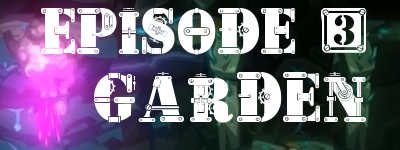 I have no idea where the black flashing you see at the start of the video comes from, I spent a lot of time trying to eliminate it with no luck (hence why the episode is late). I have to say that I really love the variety of environments the game will throw at you even early on. In Dig 1 you had clean breaks from one area to the next and while that worked OK the first few areas had very much the same character, lighting and challenges. The dark section here to get below the wall is a fun and interesting transition area that hints at something we'll probably end up seeing more of with its own set of enemies and challenges. It's really nice to be surprised by something like that at a point where you didn't really expect that as it was still early in the game and the mine environment hadn't worn out its welcome yet.
|
|
|


















